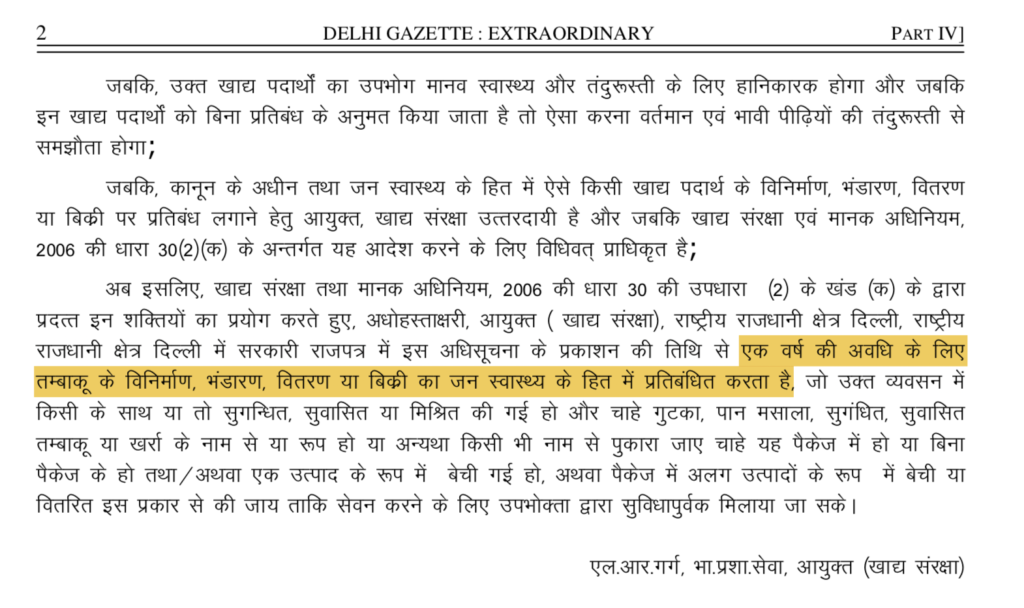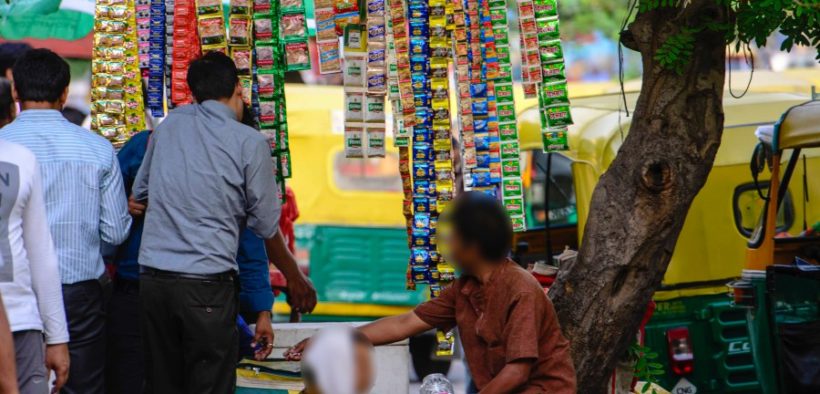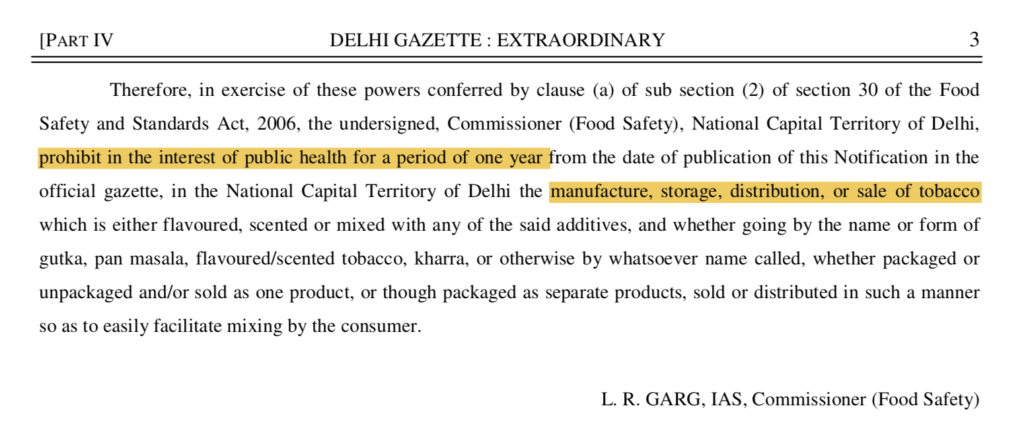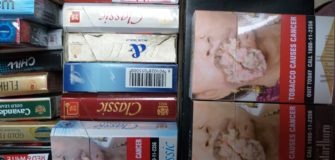भारत में तंबाकू उत्पादों पर प्रतिबंध से जुड़े तथ्य

“WHO-SEARO की रिपोर्ट 2004 के अनुसार तंबाकू खाने से सार्वजनिक स्थानों पर लोग अधिक थूकते हैं और इस तरह संक्रामक रोगों जैसे तपेदिक या टी.बी. फैलने का ख़तरा बढ़ जाता है। तंबाकू खाने के बाद लोग अक्सर थूकते रहते हैं और इस वजह से विकासशील देशों में हवा के माध्यम से संक्रामक रोग फैलने की आशंका बढ़ जाती है।”
दिल्ली सरकार ने गुटका, पान मसाला, ख़ुश्बूदार तंबाकू, ख़र्रा और ऐसे अन्य उत्पादों पर एक और साल के लिए प्रतिबंध बढ़ा दिया है जिन में तंबाकू होता है।
सितम्बर 2012 में दिल्ली ने तंबाकू या निकोटिन वाले गुटके और पान-मसाले पर प्रतिबंध लगा दिया था। इस अधिसूचना के बाद गुटका बनाने वालों ने पान-मसाले और गुटके में से तंबाकू जैसे हिस्सों को अलग कर दिया था।
क्योंकि अधिसूचना में “गुटके और पान-मसाले में तंबाकू होता है” वाक्य का प्रयोग हुआ था इस लिए प्रतिबंध के बाद तंबाकू अलग पैकेट में बेचा जाने लगा।
इस अधिसूचना को मार्च 2015 में बदलकर इसे और अधिक सख़्त बनाते हुए दोहरे पैकेट सहित धुँए रहित तंबाकू वाले सभी उत्पादों (SLT) पर प्रतिबंध लगाया गया।
धुँएरहित तंबाकू के लिए नियम क्यों ज़रूरी है?
विश्व स्वास्थ्य संगठन और दक्षिण-पूर्व एशिया क्षेत्रीय कार्यालय (WHO-SEARO) ने धुँएरहित तंबाकू को नियंत्रित करने और इस के निवारण की कड़ी सिफ़ारिश की थी।
WHO-SEARO की रिपोर्ट 2004 के अनुसार तंबाकू खाने से सार्वजनिक स्थानों पर लोग अधिक थूकते हैं और इस तरह संक्रामक रोगों का ख़तरा बढ़ जाता है। खुले स्थानों में थूकना जन स्वास्थ्य के लिए एक बड़ा ख़तरा है। तंबाकू खाने के बाद लोग अक्सर थूकते रहते हैं और इस वजह से विकासशील देशों में हवा के माध्यम से संक्रामक रोग फैलने की आशंका बढ़ जाती है। तपेदिक या टी.बी. भी ऐसा ही एक रोग है। जो लोग सार्वजनिक स्थानों पर नहीं थूकते हैं उन्हें अपना बचाव करने का पूरा अधिकार है।
वैश्विक वयस्क तंबाकू सर्वेक्षण 2016-17 के अनुसार भारत दुनिया में तीसरे नम्बर का सबसे बड़ा तंबाकू उत्पादक और दूसरे नम्बर का सबसे बड़ा तंबाकू उपभोक्ता राष्ट्र है। तंबाकू की वजह से होने वाली मृत्यु भारत में इतनी अधिक है कि ये पूरी दुनिया में होने वाले सभी तरह के मुँह के कैंसर के लगभग आधे के बराबर है और फेफड़े के कैंसर को भी इस ने पीछे छोड़ दिया है।
वर्तमान समय में भारत टी.बी. उन्मूलन के लिए राष्ट्रीय सामरिक योजना (NSP) 2017-2025 चला रहा है। NSP के अनुसार भारत पचास से अधिक सालों से टी.बी. नियन्त्रण कार्यक्रमों में लगा हुआ है। लेकिन अभी भी टी.बी. भारत में एक बड़ी बीमारी बनी हुई है। इस की वजह से अनुमानित तौर पर हर रोज़ 1400 से अधिक और हर साल 4,80,000 भारतीय मर जाते हैं।
तंबाकू के उपयोग से जुड़ी ग़लत धारणाएँ:
उत्तर प्रदेश, भारत में वैश्विक युवा तंबाकू सर्वेक्षण 2002 के अनुसार ऐसी ग़लत धारणा थी कि तंबाकू दाँतों के लिए अच्छा होता है। बहुत सी कंपनियों ने इस ग़लत धारणा का फ़ायदा उठाया और अपने उत्पादों को दाँतों की देखभाल वाला उत्पाद बता कर बेचा। लाल दँत मँजन के पाँच सेंपलों के परीक्षण में एक प्रयोगशाला ने पाया कि इस में प्रति ग्राम मँजन में 9.3-248 मिली ग्राम तंबाकू था जबकि कंपनी ने इस में तंबाकू होने की कोई जानकारी नहीं दी थी।
भारत में तंबाकू उत्पादों पर प्रतिबंध लगने के बाद की मौजूदा स्थिति:
दिल्ली में गुटके पर लगे प्रतिबंध के तीन साल बाद और सभी धुएँरहित तंबाकू उत्पादों पर प्रतिबंध के एक साल बाद मार्च-दिसम्बर 2016 में धुएँ रहित तंबाकू के बारे में दिल्ली के शहरी घरों को शामिल करते हुए सर्वेक्षण किया गया।
दिल्ली के शहरी इलाक़ों से 1710 घरों को इस सर्वेक्षण में शामिल किया गया था। इन में से 1628 घरों से सर्वेक्षण में शामिल होने के लिए योग्य व्यक्तियों ने अपनी सहमति दी थी।
सर्वेक्षण में कहा गया कि हमारे सर्वेक्षण 2016 के अनुसार तीन वर्षों तक गुटका प्रतिबंध और एक साल के लिए धुएँरहित सभी तंबाकू उत्पादों पर लगे प्रतिबंध के बावजूद शहरी दिल्ली में 18,33,499 वयस्क पुरुषों ने धुएँरहित तंबाकू का सेवन किया था।
सर्वे से ये भी पता चला कि धुएँरहित तंबाकू का शहरी दिल्ली में दोहरे पैकेट में ख़ूब प्रयोग होता है और खैनी सबसे ज़्यादा पसंदीदा उत्पाद है। संशोधित अधिसूचना 2015 के बावजूद धुएँरहित सभी तंबाकू उत्पादों पर लगा प्रतिबंध गुटके तक सीमित है।
खाद्य सुरक्षा विभाग, एनसीटी, दिल्ली द्वारा 13 अप्रैल 2019 को तंबाकू उत्पादों पर लगे प्रतिबंध को एक और साल के लिए बढ़ाए जाने का हर प्रकार से स्वागत किया गया।

धुएँरहित तंबाकू उत्पादों पर लगे प्रतिबंध को बढ़ाने के बारे में विशेषज्ञों की राय:
दिल्ली उच्च न्यायालय और दिल्ली ज़िला अदालत में एडवोकेट H.P.Rao ने कहा कि सरकार ने अधिसूचना में धुएँरहित तंबाकू उत्पादों के लिए दरवाज़े बंद किए हैं लेकिन जब तक इन उत्पादों के खाने पर प्रतिबंध नहीं होगा तब तक समाज को बड़े पैमाने पर कोई लाभ नहीं मिल पाएगा।
ये पूछने पर कि क्या दिल्ली में तंबाकू खाने पर भी प्रतिबंध है; संबंधित प्रशासन ने कोई जवाब नहीं दिया।
दिल्ली उच्च न्यायालय और दिल्ली ज़िला अदालत में एडवोकेट और NDPS अधिनियम तथा मामलों के विशेषज्ञ नितिन जोशी के कहा कि भारत में मादक पदार्थ और नशीली दवाओं के अधिनियम (NDPS)1985 के अनुसार देश में विभिन्न दवाओं की मात्रा, उन्हें रखने, उनका उपयोग करने, निर्माण करने, बेचने और ख़रीदने के नियम बताए गए हैं। अगर कोई व्यक्ति बेचने के लिए तय मात्रा से कम, लेकिन रखने के लिए कम मात्रा से अधिक में इन पदार्थों को अपने पास रखता है तो उसे इस अधिनियम के अंतर्गत गिरफ़्तार किया जा सकता है। जब तक संबंधित अधिनियम या अधिसूचना में धुएँरहित तंबाकू उत्पाद की मात्रा और इसे रखने से जुड़े नियम नहीं बताए जाएँगे तब तक इन उत्पादों पर प्रतिबंध से कोई लाभ नहीं होगा।
वैश्विक वयस्क तंबाकू सर्वेक्षण भारत की रिपोर्ट 2016-2017 से पता चलता है कि भारत में खैनी सबसे ज़्यादा इस्तेमाल किया जाने वाला उत्पाद है और हर 9वाँ वयस्क इस का इस्तेमाल करता है।
भारत में धूप में सुखाए गए तंबाकू और बुझे हुए चूने के मिश्रण को कुछ क्षेत्रों में खैनी, सदा या सुरती आदि नामों से जाना जाता है। इस मिश्रण को खाने वाला आमतौर पर ख़ुद तैयार करता है। वे तंबाकू और चूने को अपने हाथों से मिलाते हैं और फिर मुँह में रख लेते हैं। दस से पंद्रह मिनट तक ये मिश्रण मुँह में रखा रहता है और कुछ-कुछ देर के बाद इसे चूसा जाता है।
दिल्ली सरकार के अतिरिक्त स्वास्थ्य निदेशक, डॉ. एस. के. अरोड़ा ने कहा कि हालांकि दिल्ली और भारत के अन्य राज्यों में गुटका और ख़ुश्बूदार चबाने वाले तंबाकू पर प्रतिबंध है लेकिन खैनी जैसे कच्चे या किसी और नाम से मिलने वाले चबाने वाले तंबाकू पर किसी भी प्रावधान के अंतर्गत कोई प्रतिबंध नहीं लगाया गया है।
डॉ. अरोड़ा ने आगे कहा कि मैंने अप्रैल 2016 और जून 2018 में, दो बार भारत सरकार के खाद्य सुरक्षा और मानक प्राधिकरण के अध्यक्ष को पत्र लिख कर सुझाव दिए कि खैनी और अन्य उत्पादों की ‘Raw Chewable Tobaccos’ के रूप में लेबल के लिए व्याख्या में केन्द्रीय अधिनियम में बदलाव किया जाए और फिर खाद्य सुरक्षा अधिनियम 2011 के अंतर्गत नियम 2.3.4 के तहत इन पर प्रतिबंध लगाया जाए। लेकिन अभी तक हम किसी कार्यवाही का इंतज़ार कर रहे हैं।
1 अप्रैल 2019 को The Lancet में छपे एक अध्ययन से पता चलता है कि भारत में युवाओं को अभी भी प्रचार माध्यमों से धुएँरहित तंबाकू की जानकारी मिलती है और ये प्रचार बहुत अधिक है।
भारत में किए गए वैश्विक युवा तंबाकू सर्वेक्षण 2016-17 के अनुसार लगभग सत्तर प्रतिशत छात्रों ने धुएँरहित तंबाकू उत्पादों का प्रचार बिलबोर्ड्स पर देखा और पचास प्रतिशत ने फ़िल्मों या फिर टेलिविजन पर।
अस्वीकरण: लेख में बताए गए विचार विशेषज्ञों और विभिन्न रिपोर्टों से लिए गए हैं और ये द हेल्थ या इस के सदस्यों या कर्मचारियों के निजी विचार नहीं हैं।




















